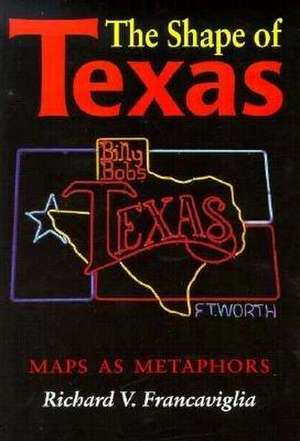The Shape of Texas: Maps as Metaphors: Texas A & M University Military
Autor Richard V. Francavigliaen Limba Engleză Hardback – 30 sep 1995
Over the years America's most recognizable state outline has become one of its most potent symbols, a metaphor for Texas popular culture. In the last decade, the private, commercial, and official use of the Texas map as cultural symbol has boomed.
Richard V. Francaviglia identifies this current trend as "Tex-map mania," and contends that the Texas map as icon integrates geography with history--and gives shape to a mythic landscape and to abstracted notions of what Texas is and who Texans are.
Written in a lively style that engages both the scholar and
the general reader in a discussion of the power of symbol and the
meaning and significance of a shared aesthetic, The Shape of Texas is at the crossroads of cartography and popular culture. Francaviglia uses more than one hundred illustrations in offering a provocative visual and written account of this important, yet much neglected, aspect of Texas history and the dynamics of a still emerging Texas identity.
Preț: 227.09 lei
Preț vechi: 258.44 lei
-12% Nou
Puncte Express: 341
Preț estimativ în valută:
43.46€ • 47.19$ • 36.51£
43.46€ • 47.19$ • 36.51£
Carte indisponibilă temporar
Doresc să fiu notificat când acest titlu va fi disponibil:
Se trimite...
Preluare comenzi: 021 569.72.76
Specificații
ISBN-13: 9780890966648
ISBN-10: 0890966648
Pagini: 144
Dimensiuni: 160 x 240 x 16 mm
Greutate: 0.43 kg
Editura: Texas A&M University Press
Seria Texas A & M University Military
ISBN-10: 0890966648
Pagini: 144
Dimensiuni: 160 x 240 x 16 mm
Greutate: 0.43 kg
Editura: Texas A&M University Press
Seria Texas A & M University Military
Textul de pe ultima copertă
Over the years America's most recognizable state outline has become one of its most potent symbols, a metaphor for Texas popular culture. In the last decade, the private, commercial, and official use of the Texas map as cultural symbol has boomed. Richard V. Francaviglia identifies this current trend as "Tex-map mania", and contends that the Texas map as icon integrates geography with history - and gives shape to a mythic landscape and to abstracted notions of what Texas is and who Texans are. Written in a lively style that engages both the scholar and the general reader in a discussion of the power of symbol and the meaning and significance of a shared aesthetic, The Shape of Texas is at the crossroads of cartography and popular culture. Francaviglia uses more than one hundred illustrations in offering a provocative visual and written account of this important, yet much neglected, aspect of Texas history and the dynamics of a still emerging Texas identity.
